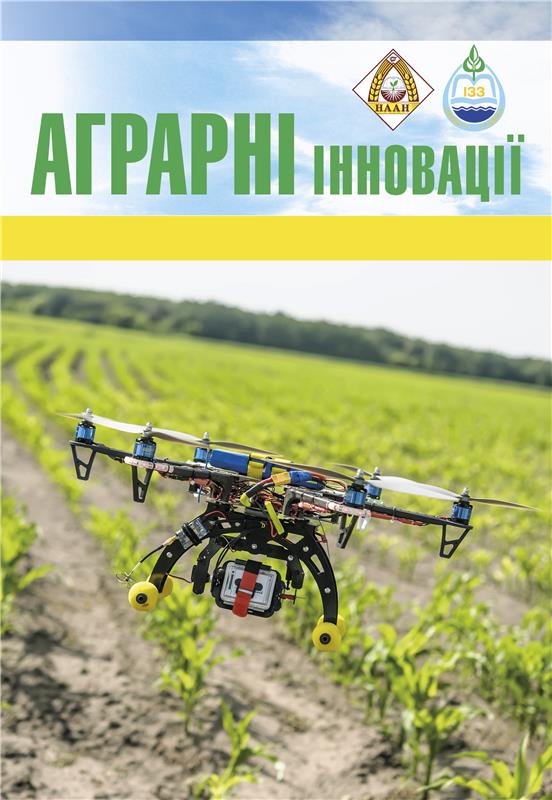QUALITY INDICATORS OF DIFFERENTIAL SUNFLOWER HYBRID SEEDS DEPENDING ON MICRO-FERTILIZERS IN THE CONDITIONS OF THE WESTERN FOREST-STEPPE
Abstract
Purpose. The purpose of the research was to establish the influence of foliar application of microfertilizers on the quality indicators of seeds of different-ripening sunflower hybrids when grown in the conditions of the Western Forest-Steppe.Methods. In the process of conducting the research, a combination of general scientific methods was used: hypothesis, observation, analysis; and special methods: laboratory and field. Experimental indicators were processed by methods of mathematical statistics.Results. The results of field and laboratory studies of comparative assessment of the sunflower hybrids pro- ductivity (Phenom (mid-early), NK BRIO (mid-ripening), Valencia (mid-ripening), NK CONDI (mid-ripening)), theinfluence of microfertilizers (Multicomplex StimOrganic, StimOrganic AminoMax, Avangard Complex Sunflower) at different application times (phase 2-4 leaves, phase 2-4 leaves + phase 5-6 leaves). The results of the research established the feasibility of growing the studied hybrids in the soil and climatic conditions of the Western Forest-Steppe and optimized the set of agrotechnical measures.Findings. The research established a significant difference in the hybrids by the weight of a thousand seeds, the indicator varied from 50 to 68 grams. The most weighty seeds were in the hybrid NK CONDI and the least – in the Valencia hybrid. With two-time feeding with microfertilizers (phase 2-4 leaves + phase 5-6 leaves), a significant excess of controls was noted, the optimal effect was in the Valencia hybrid with the microfertilizer Multicomplex StimOrganic, the excess of control was 5 g (10%). The Valencia hybrid was characterized by the smallest weight of 1000 seeds, however, the yield of this hybrid compared to the three other hybrids was the highest, which is explained by biometric indicators: basket diameter and number of seeds in the basket. In the variants of foliar application of microfertilizers in the phase of 2-4 leaves, the weight of 1000 seeds increased in some variants by 1-2 grams. As a result of the research, it was determined that with a single application of microfertilizers in the phase of 2-4 leaves of sunflower, the fat content in seeds increased by 1-2%. The plasticity of the Valencia hybrid with respect to the influence of microfertilizers both during a single and two-time top dressing was substantiated. The fat content in sunflower hybrids was within 48-52%. The optimal fat content of 55% was in the Valencia hybrid with two-time top dressing with the microfertilizer Multicomplex StimOrganic, the control excess was 4%.
References
2. Боровська І. Фізіологічні потреби соняшника – новий виклик природи. Зерно. 2020. № 7. С. 38-39.
3. Вожегова Р. А. Ефективність сучасних технологій вирощування соняшнику за різних умов зволоження та способів і глибини основного обробітку ґрунту на півдні України / Р. Вожегова, М Малярчук, О. Митрофанов, А. Мігальов, В. Малярчук. Техніка і технології АПК. 2013. № 1. С. 19-21.
4. Гаврилюк М. М., Салатенко В. Н., Чехов А. В. Олійні культури в Україні – навч. посібник [за редакцією Салатенка В. Н.]. К. Основа, 2008. 420 с.
5. Гамаюнова В. В., Коваленко О. А., Хоненко Л. Г. Сучасні підходи до ведення землеробської галузі на засадах біологізації та ресурсозбереження. Раціональне використання ресурсів в умовах екологічно стабільних територій : кол. моногр. Полтава : ТОВ НВП «Укрпромторгсервіс», 2018. С. 232-342.
6. Коваленко О. А. Агроекологічне обґрунтування та розробка елементів біологізованих технологій вирощування сільськогосподарських культур в умовах Півдня України. – Кваліфікаційна наукова праця на правах рукопису. Дисертація на здобуття наукового ступеня доктора сільськогосподарських наук за спеціальністю 06.01.09 – рослинництво. Херсонський державний аграрно-економічний університет, Херсон, 2021. 592 с. 15.
7. Коваленко О. А., Нерода Р. С., Пачесна І. В., Тупчій Д. Ю. Вплив біопрепаратів на продуктивність соняшника. Перлини степового краю: матеріали Всеукр. наук.-практ. конф., м. Миколаїв, 20-22 листоп. 2019 р. Миколаїв : МНАУ, 2019. С. 76-78.
8. Коваленко О. А., Федорчук М. І., Нерода Р. С., Донець Я. Л. Вирощування соняшника за використання мікродобрив та бактеріальних препаратів. Вісник Полтавської державної аграрної академії. 2020. № 2. С. 111-134.
9. Кучерявий В. Л. Екологія. Львів : Світ, 2000. 500 с.
10. Маслак О. Привабливість олійних культур. Економічний гектар, 2015. № 22. С. 24-29.
11. Санін В., Санін Ю. Особливості позакореневого підживлення мікроелементами. Пропозиція. 2012.
12. Ушкаренко В. О., Лазер П. Н., Каплін О. О. Біоенергетична ефективність вирощування скоростиглих гібридів соняшника в основних та проміжних посівах при зрошенні. Таврійський науковій вісник. Вип. 33, 2004. С. 3-9.
13. Шевченко В. П. Каленська С. М., Демидась П. І. Біологічне рослинництво. Київ. Видавничий центр НАУ, 2006. 39 с.
14. Ярошко М. Вирощування соняшнику в умовах посухи. Агроном. 2020. № 4. С. 86-89.






